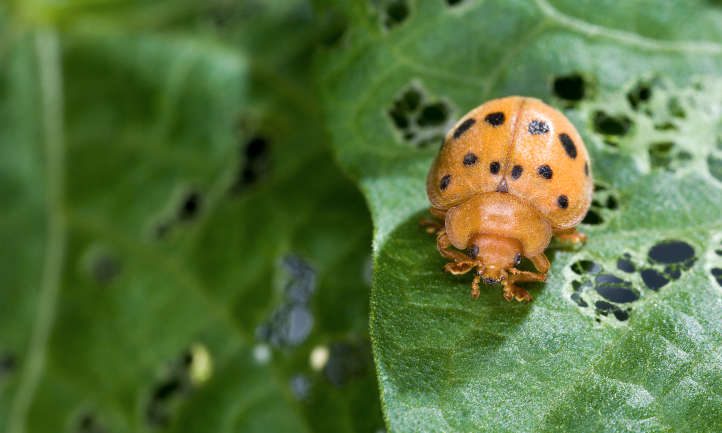Have you ever come out to your garden to find bugs on beans you planted and wondered, “What is eating my green bean leaves?” Chances are you’re dealing with the Mexican bean beetle. In the scope of natural history, this pest was first identified in 1850 by Mulsant via multiple specimens from Mexico.
While the Mexican bean beetle is in the same family as the lady bug its feeding damage makes it much less desirable in home gardens. This bug has a national origin in Mexico but has spread to parts of Central America, most of the Western United States, and even Southern Canada. This orange-yellow beetle and its larvae are the bane of the bean grower’s existence.
Feeding occurs on snap peas and lima beans, the mung bean plant, the red clover plant, and other bean types. This insect has been so detrimental to bean production, there are studies devoted to understanding its behavior and learning ways to control it. That’s no surprise because, unlike other insects that feed on plants, these feed in almost every developmental stage. The larvae can be just as damaging as adults.
So let’s talk about the Mexican bean beetle, and cover ways you can control them in your garden. That way, you can have a ton of lovely bean pods to harvest in the coming season.
Subscribe to the Epic Gardening Podcast on iTunes or Spotify
Overview
| Common Name(s) | Mexican bean beetle |
| Scientific Name(s) | Epilachna varivestis |
| Family | Coccinellidae |
| Origin | Mexico & the United States |
| Plants Affected | Common beans, lima bean, mung bean plant, thicket bean, soybeans, adzuki bean, cowpeas, alfalfa, red clover plant, and other clovers |
| Common Remedies | Hand-picking beetles, insecticidal soaps, neem oil, pyrethrin or azadirachtin sprays, diatomaceous earth, kaolin clay, beneficial insects (ladybugs, lacewings, minute pirate bugs, spined soldier bugs), floating row covers |
What Is the Mexican Bean Beetle?
The bean beetle is one of two of the most destructive species in the Coccinellidae family. Epilachna varivestis is one of the rare lady beetles that feeds on plants instead of other pests. It is sometimes referred to as the bean ladybird. If you compare Mexican bean beetle vs ladybug, it’s easy to tell which is a pest and which is a beneficial garden dweller.
Its color varies, making it hard to distinguish at times from the ladybug, but at other times quite easy to identify. Typically, it is found in shades of bright yellow to rusty brown. It can sometimes be bright orangish-red. The bean beetle has eight dark black spots on each of its elytron, the hardened upper forewings that appear to cover its back when it’s at rest. These insects consume all parts of bean plants: bean leaves, pods, and stems. As they consume leaf tissue, they remove the bean plants’ ability to photosynthesize, causing crop damage.
Life Cycle of Mexican Bean Beetles
In the late spring, overwintering adults emerge from their moist, protected sites. Female Mexican bean beetle adults lay eggs in groups of 50 to 75 on the undersides of leaves. The eggs hatch and a new life cycle begins.
Once the soft-bodied larvae hatch, they feed rapidly throughout a field, laying waste to crops. The worst damage occurs during the four larval stages where they grow, and pass through moulting cycles. During each of these cycles the larvae shed their upper epidermis and become larger. Once they are at their full size, the larvae attach themselves to the underside of a leaf and pupate there. This cycle takes 1 to 2 weeks.
After this, they emerge from the pupa, entering the last part of a complete life cycle. An adult Mexican bean beetle can begin the cycle once more. When the weather becomes cold in the late fall, the Mexican bean beetle overwinters in the shelter of local woodlands or hides in leaf litter for the winter.
Identifying Mexican Bean Beetles
Mexican bean beetle larvae are easy to identify because they have a distinct look that sets them apart from other members of their clade. These light yellow larvae are very small, but their spiky, oval-shaped visage stands out among the green leaves of wax beans. Branched spines come in six longitudinal rows on the back of the larvae. The spikes of each Mexican bean beetle larva start out yellow and darken as life stages continue. They’ll gather together just before they enter the pupa. This is a great time to eliminate them and stop the life cycle altogether.
If the Mexican bean beetle larvae make it to the pupal stage, they’ll attach to the undersides of leaves, pods, and stems of bean plants. Sometimes they’ll even attach to nearby plants. In this position, their skin is pushed back from their thorax to their abdomen, where it takes on a white, wrinkled form. The rest of the pupa becomes spineless.
When the adult Mexican bean beetle emerges from the pupa, it’s often straw-colored, has a wing cover, and few to no spots. After a period, 8 black spots appear in three rows. As they age, they develop a coppery brown shell, and the spots fade slightly.
Bean Bug Damage and Habitat
Bean bugs are found throughout Mexico, through the eastern United States, and even in Canada. They flourish in irrigated croplands west of the Rocky Mountains. Like most pests, they go where their food supply is most abundant. They have no problem going long distances to habitate in early spring and then again to overwintering locations. They are most prevalent during the spring, summer, and early fall months. The most destructive time of year for them is the early summer. Then overwintering adults retreat to a sheltered location in nearby woodlands or under nearby plant debris.
They’re fond of bean leaves and bean pods. They don’t discriminate and also feast on the stems of bean plants. They eat common beans, lima beans, mung bean, thicket bean, soybean, adzuki bean, cowpeas, alfalfa, snap beans, and some clovers. Their leaf feeding damage during the growing season comes in the form of a skeletonized appearance. This makes it a bit easier to notice the danger lurking under the foliage and take steps to eliminate them.
Bean Beetle Look Alikes
We’ve mentioned that the adult Mexican bean beetle looks a lot like ladybird beetles, also know as lady bugs. There are a few destructive species in the same family. Adult beetles also slightly resemble the bean leaf beetle (Cerotoma trifurcata), the Asian lady beetle (Harmonia axyridis), the squash lady beetle (Epilachna borealis), and the spotted cucumber beetle (Diabrotica undecimpunctata). All of the adult beetles in these species have dots, which makes knowing how to handle them difficult. Let’s discuss a few of the differences between the Mexican bean beetle and these look alikes. One thing to note is the destructive ones tend to have lines of dots, rather than a scattering of dots.
- Bean leaf beetle (Cerotoma trifurcata): easier to tell apart due to area punctuated just above its posterior; often yellow or red
- Asian lady beetle (Harmonia axyridis): sometimes orange, but most often a shade of red with a black and white head; spots range from none to 22
- Squash beetle (Epilachna borealis): very similar in appearance but has 7 spots on the wing covers and 4 on its head
- Spotted cucumber beetle (Diabrotica undecimpunctata): similar to the bean leaf beetle in structure but always greenish-yellow with stark black dots
Bean Beetles As Disease Vectors
Another risk to allowing the beetle life cycle to carry on in your garden is they sometimes transfer diseases to your bean patch while they feed. The main concern when it comes to bean leaf beetles as disease vectors is bean pod mottle virus. Most often affecting soybean plants, this virus causes mottling and puckered leaves. It’s hard to tell this virus and cucumber mosaic virus apart, but both reduce yields and affect the quality of the seedcoat. If you find diseased leaves, quarantine the plant, remove a leaf, and send it to your local extension office for testing. They should be able to advise you on which disease is present and what course of action you should take.
Controlling the Mexican Bean Beetle
Now that we have examined the yellow larva of these featured creatures, and the associated risk of the Mexican bean beetle, let’s discuss ways to control them. Then you can continue growing your favorite snap beans successfully.
Cultural Control
Because Mexican bean beetles overwinter in plant matter and moist, protected locations, you can destroy these before the season begins to prevent feeding damage while your beans are growing. Do this before early spring when the beetle makes its way out of those isolated areas where overwintering occurs.
Another gardening practice that can offset a beetle infestation is delayed planting. Plant your snap beans later in the season and after you destroy areas where Mexican bean beetles overwinter, and you may have success offsetting some of the damage the adults and larvae create.
Planting early maturing bean varieties may be one way to reduce the destruction of these pests. While these bugs are present in the earlier months, they’re still just coming out of hibernation. An early maturing variety may be well-established and able to handle the damage prior to bean beetle infestation. Also, bush beans are more resistant than pole beans. If you opt to plant bush beans instead, you may be able to reduce the population simply from that.
Biological Control of Mexican Bean Beetles
Biological control is the most effective way to keep the numbers of adults and larvae down. Adults emit a toxin from their leg joints, but specific predators can surpass that defense and keep numbers down.
The best biological control is to invite in natural predators. You might think it’s odd to use a ladybug to control a relative of the ladybug. However, in this instance, it works well. Ladybugs prey on insect eggs, and they’re not picky. Whether it’s aphids and their eggs, the bright yellow beetle egg, or any other insect, they’ll consume them. These insects truly will help with most other forms of pests.
Another excellent biological control and beneficial insect is the lacewing. These little green bugs are pleased to help gobble up eggs and Mexican bean beetle larvae, and they don’t harm anything in your garden. The minute pirate bug is also a great beneficial insect for your garden. These keep the leafhopper pest population down and kill off Mexican beetle pests, preventing further feeding damage. Spined soldier bugs love to eat all sorts of pests, from egg clusters to a Mexican bean beetle larva, all the way through the adult stage. They also help you with potato bugs or cutworms that cause crop damage elsewhere.
Insecticidal Removal of the Mexican Bean Beetle
Along with biological controls, you can use organic and chemical insecticides. Spot treatments with insecticidal soaps work well if you’re seeing limited quantities of a bean beetle population in your yard. This will wipe out what’s there and discourage a longer stay. Thoroughly coat both the top and bottom of the leaves as well as the plant stems to make this effective.
Neem oil is also an effective means of control. While it’s less likely to kill adults, it does deter them from laying eggs on neem-coated leaves, and it slowly poisons larvae. It’s even more effective when blended with an insecticidal soap. Neem oil also prevents infestations of other insects such as aphids and the leafhopper. Only spray in the morning before the sun rises and before pollinators have begun their hard work. Avoid spraying neem when temperatures are 90°F, as this can burn plants.
Another option is to use pyrethrins. Use a spray that contains a blend of potassium salts of fatty acids and pyrethrins. These work for other pests, including cabbage worms, spider mites, the cabbage looper, and more. If that doesn’t work, opt for a stronger pyrethrin spray. Follow the manufacturer’s directions for dealing with a heavy infestation, and you should be rewarded with a bunch of dead adult and larval bugs.
Finally, consider an azadirachtin spray. Azadirachtin is the active ingredient that makes neem oil so effective, but in this case it’s more concentrated. This poisons both adult and larvae and destroys the eggs. It also deters future infiltration by the Mexican beetle.
One important consideration for working with even organic insecticides is you need to avoid spraying yellow ladybugs, which look a lot like the bean beetle.
Preventing Mexican Bean Beetles
Keep your beds clear of plant debris from the fall throughout the winter. Debris, fallen leaves, and the like make an excellent shelter for overwintering adult beetle populations. By keeping the area clear, you don’t have long-term beetles on beans.
Use floating row covers to keep all sorts of pests away. The cucumber beetle, asparagus beetle, and flea beetle are deterred with this method. This also prevents moth larvae like army worms or the tomato hornworm.
Apply a light dusting of kaolin clay. This superfine clay forms a waxy coating over the surface of leaves, deterring pests from eating them or laying eggs on them.
Growing rosemary or marigolds keeps the pests from colonizing your yard initially. Other plants like nasturtium or summer savory may work as well.
Frequently Asked Questions

Q: How do I get rid of Mexican bean beetles?
A: There’s a great section in this article about control. Check that out!
Q: Are bean beetles harmful?
A: Yes, they can do a lot of damage quickly. It’s important to prevent and control them as much as possible.
Q: What does the Mexican bean beetle feed on?
A: Beans, beans, and more beans! Leaves, stems, and pods.
Q: How do you get rid of Mexican bean beetles naturally?
A: The biological controls section of this piece has some good options for natural removal methods. So does the insecticidal removal section.
Q: What plants keep bean beetles away?
A: You can trap them with rosemary or marigold. You can also plant hosts for predatory insects.
Q: Do Mexican bean beetles live in the soil?
A: Technically no, but they do overwinter in plant refuse.
Q: Do Mexican bean beetles bite humans?
A: Just ilke lady bugs, they can. Though they prefer bean plants.
Q: How long do Mexican bean beetles live?
A: Their entire life span is roughly 2 to 5 weeks.
Q: How can you tell the difference between the adult beetles and ladybugs?
A: Typically, Mexican bean beetle colors are orange to copper, with the same basic pattern of eight spots per forewing. When you find an orangish-red “ladybug”, look closely at the wings. If it has the same eight-spotted pattern on both forewings, get rid of it, it’s a Mexican bean beetle!








